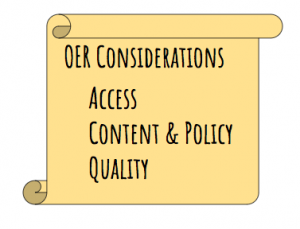Over the past twenty years, school districts have become much more prescriptive about what happens in their classrooms. Teachers no longer open up a textbook and start on page one and progress through the book until they get to the end (or the school year comes to a close). Many districts not only provide a scope and sequence so a teacher knows what to teach and in what order, but in many cases, they also provide lesson plans so that every student gets the content taught in the same manner. The creation of Open Educational Resources (OER) for these districts is the next logical step in tailoring the state standards for their student’s needs.
Why OER?
In a recent survey, Texas technology directors indicated that 30 percent of their school districts are currently investigating the use of OER and 56 percent say they are open to their use, but need more information. Open Educational Resources are teaching, learning, and research resources that reside in the public domain or have been released under a license that permits their free use, reuse, modification, and sharing with others. Over the past year, we have published several blog posts related to OER. So if your district is in the beginning stages of looking into OER you might want to read some of the following posts
- It’s Time: #GoOpen
- Creative Commons: Make OER Copyright Simple
- Finding Quality OER Made Easy
- OpenStax Provides High-Quality OER for Texas Schools
- TEA Partners with Study Edge to Create OER
- Why and How El Paso ISD Went Open
Ready to Go Further?
If your district has already investigated the use of these resources and decided to begin the process of implementing these free instructional materials aligned to the state standards, the following steps may help guide your efforts. These steps, created by Achieve.org, were included in a document designed to help states implement a state OER initiative. I’ve adapted the steps so they fit within the context of a school or district.
1. What’s your vision?
![]() The first thing you must do is make sure that you know how OER will be used within your school or district. You must be able to envision what the ideal OER system would look like, including the expected impact it will have on your teachers and students. Below are some of the questions you should be able to answer:
The first thing you must do is make sure that you know how OER will be used within your school or district. You must be able to envision what the ideal OER system would look like, including the expected impact it will have on your teachers and students. Below are some of the questions you should be able to answer:
- Why is your school or district considering the use of OER?
- Is it it reduce the costs of instructional materials?
- Do you want more control over the instructional materials used within your classrooms?
- Do you see it as a professional learning opportunity for your teachers as they curate and create instructional materials?
- What will be the impact on teachers?
- How will you manage the process so that it empowers teachers?
- What will be the impact on students?
- How will you ensure that every student has access to the instructional materials whether they are at home or school?
- What needs to be in place to make this happen?
- How will you measure success with teachers?
- How will you measure success with students?
- Who do you need to share this vision with?
- How will you get them to buy into the vision?
2. What resources do you need?
You next must determine what resources you will need to deploy the OER to your teachers and students. This includes key personnel, technical infrastructure, instructional materials, and software. One of the biggest issues you will need to deal with is the quality of your OER. Your team will need to answer the following questions:
Access
- What portal or system will you use to share resources?

- Is there an existing system you can use?
- How will you handle licensing/copyright?
- How “open” will materials be?
- How will you address technology infrastructure challenges?
- What devices will be accessing your OER? If devices are necessary, do all your students have a device that can access the OER and, if not, how will you overcome this barrier?
Content and Policy
- Will you curate existing resources, create your own, or a mix of the two?
- Will you use the OER that were produced for TEA by OpenStax or Study Edge?
- How will you work within or address curriculum and textbook adoption policies and funding restrictions?
Quality
- How will you define quality?
- What rubrics will you use?
- How will you evaluate quality of the OER curated or created by your teachers?
- Who will conduct the evaluations?
3. What’s your timeline?
Now that you know what you want to accomplish, you can begin to sketch out the timing of the each of the steps. Use these questions to guide your discussion.
- What is the timeline for implementing priority activities?

- Is there a final deadline you are working toward?
- Are there other time-sensitive activities to consider?
- When will each activity need to be completed?
- Are there deadlines or milestones along the way?
- What timelines already exist for roll out of instructional materials or professional development that you could build upon?
4. Who will design and implement the plan?
You will need to identify the key stakeholders and define their roles in the creation and implementation of the OER. For each of the stakeholders, you will need to answer these questions:
- What part should each stakeholder be responsible for?
- What do they need to know, understand, or be able to do?
- What kind of training do they need?
5. What’s your communications strategy?
For any new initiative, communications is key. It is best if you include this in your plan. Identify the groups you need to communicate with and consider the following questions:
![]()
- What is the stakeholder’s current level of engagement? High or low?
- Ideally, what would the engagement of this stakeholder look like?
- How will you engage this stakeholder?
- What is your message to this stakeholder?
- How will you know your message is reaching this stakeholder?
6. How will you know if it’s working?
Finally, plan now how you will determine if you have been successful in the creation, distribution, and implementation of your OER. The following questions can guide you as you design your evaluation process.
 How will you measure success?
How will you measure success? - How will you determine whether the OER is having the intended impact on educators and students?
- How will you determine whether your activities are being implemented as intended?
- What metrics will you use to assess the implementation progress?
- Who should be involved?
- Who is responsible?
- What data will be reviewed?
As you grapple with these questions, keep at the forefront the reasons why your district chose to consider Open Educational Resources in the first place. OER is more than just a way to reduce the cost of your instructional materials. The process of creating them has proven to be an excellent professional development experience for the teachers involved. The creation or modification of OER also enables you to design your instructional materials to meet the educational needs and struggles of your particular students. These questions will help your district as you move through the process of adapting and creating your own instructional materials.
Open Photo by Finn Hackshaw on Unsplash
Stickies on Chalkboard Photo by rawpixel on Unsplash
Clock Photo by Sonja Langford on Unsplash
Teacher holding Comment Photo by rawpixel on Unsplash
Puzzel Pieces Photo by rawpixel on Unsplash

